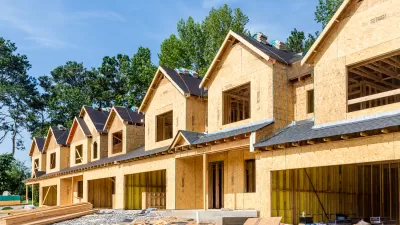This piece from Places discusses Los Angeles as a place difficult to wrap one's head around, and how light and darkness are so important to the city's identity.
This essay is by Los Angeles Times book critic David L. Ulin and is part of a new book featuring photographs of Los Angeles by Michael Light.
"This utilitarian connection to the city is one, I think, that gets to the essence of L.A. It exists at the heart of the dichotomy between private and public architecture, the pre-eminence of infrastructure, the balance between neighborhood and sprawl. Where else would we find freeway overpasses named for fallen heroes, such as the Clarence Wayne Dean Memorial Interchange, where the Antelope Valley Freeway sweeps into Interstate 5, named for the motorcycle policeman who died in that spot when his bike plunged off a piece of collapsed roadway during the Northridge earthquake? On the one hand, such a memorial seems ridiculous, reminiscent of T.S. Eliot's caustic lines: "Here were decent godless people: / Their only monument the asphalt road. / And a thousand lost golf balls." As with most things in Los Angeles, however, the surface masks another kind of depth. A site such as the Clarence Wayne Dean Interchange tells us something - not about our superficiality, but about the nature of how we live here, how we interact with our environment, which makes freeways among the most important monuments we have. It also highlights our complex relationship with the natural landscape, which can rise up at any moment to shake our most substantial structures loose. This is perhaps the least understood aspect of Los Angeles, the way it exists in the shadow of elemental forces, forces we cannot control. We build on terrain that is, in the most fundamental sense, unstable, that shakes and burns and floods with the regularity of the tides. Here again, we see the intercession of technology, and the limits of that technology at once. What does it mean that it all can fall to pieces in an instant, that what we have constructed here, no matter how apparently substantial, is as ephemeral and fleeting as a dream?"
FULL STORY: L.A. Day/L.A. Night

Pennsylvania Mall Conversion Bill Passes House
If passed, the bill would promote the adaptive reuse of defunct commercial buildings.

Planning for Accessibility: Proximity is More Important than Mobility
Accessibility-based planning minimizes the distance that people must travel to reach desired services and activities. Measured this way, increased density can provide more total benefits than increased speeds.

Fair Housing Cannot Take a Back Seat to ‘Build, Baby, Build’
If we overlook fair housing principles in the plan to build US housing back better, we risk ending up right back where we started.

LA Metro Board Approves New 710 Freeway Plan
The newest plan for the 710 corridor claims it will not displace any residents.

Austin’s Proposed EV Charging Rules Regulate Station Locations, Size
City planners say the new rules would ensure an efficient distribution of charging infrastructure across the city and prevent an overconcentration in residential areas.

Making California State Parks More Climate-Resilient
A recently released report offers recommendations for keeping state parks healthy and robust, including acquiring additional land for conservation and recreation.
City of Costa Mesa
Licking County
Barrett Planning Group LLC
HUD's Office of Policy Development and Research
Mpact Transit + Community
HUD's Office of Policy Development and Research
Tufts University, Department of Urban and Environmental Policy & Planning
City of Universal City TX
ULI Northwest Arkansas
Urban Design for Planners 1: Software Tools
This six-course series explores essential urban design concepts using open source software and equips planners with the tools they need to participate fully in the urban design process.
Planning for Universal Design
Learn the tools for implementing Universal Design in planning regulations.

























